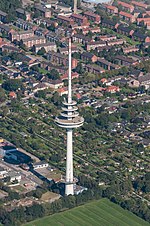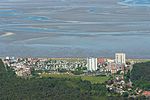Raid on Cuxhaven

The Raid on Cuxhaven (German: Weihnachtsangriff, Christmas Raid) was a British ship-based air-raid on the Imperial German Navy at Cuxhaven mounted on Christmas Day, 1914. Aircraft of the Royal Naval Air Service were carried to within striking distance by seaplane tenders of the Royal Navy, supported by both surface ships and submarines. The aircraft flew over the Cuxhaven area and dropped their bombs, causing damage to shore installations. It was described at the time as an "air reconnaissance of the Heligoland Bight, including Cuxhaven, Heligoland and Wilhelmshaven ... by naval seaplanes" during which "the opportunity was taken of attacking with bombs points of military importance" in northern Imperial Germany.
Excerpt from the Wikipedia article Raid on Cuxhaven (License: CC BY-SA 3.0, Authors, Images).Raid on Cuxhaven
Abendrothstraße,
Geographical coordinates (GPS) Address Nearby Places Show on map
Geographical coordinates (GPS)
| Latitude | Longitude |
|---|---|
| N 53.861111111111 ° | E 8.6944444444444 ° |
Address
Abendrothstraße
27474
Lower Saxony, Germany
Open on Google Maps







